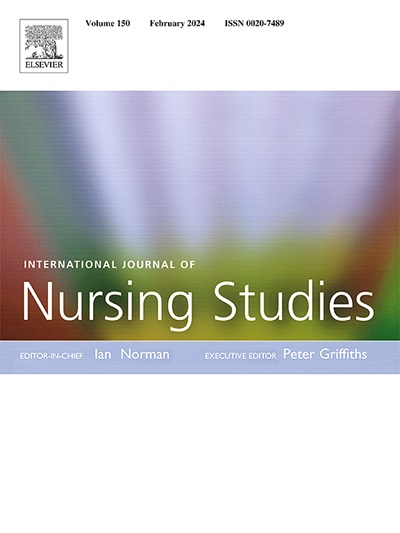Effectiveness of a low-intensity nurse-led lifestyle intervention on glycaemic control in individuals with prediabetes: The PREDIPHONE randomized controlled clinical trial
IF 7.5
1区 医学
Q1 NURSING
引用次数: 0
Abstract
Background
Lifestyle changes can effectively prevent diabetes onset in individuals with prediabetes. Although nurse-led interventions have proven to be cost-effective and feasible in the management of diabetes and hypertension in primary care, low-intensity lifestyle interventions for people with prediabetes led by nurses remain poorly evaluated.
Objective
To assess whether a low-intensity nurse-led telephone lifestyle intervention is effective in reducing fasting plasma glucose levels in individuals with prediabetes.
Design
A two-arm, parallel, randomized controlled clinical.
Settings
Five Primary Care Centres in the Balearic Islands, Spain.
Participants
A total of 206 participants were enrolled, 103 in each group.
Methods
Consenting participants aged 25–75 years, with fasting plasma glucose levels of 100–125 mg/dL, and body mass index ≥ 27 and < 40 kg/m2 were randomly assigned (1:1) to either a 9-month nurse-led telephone lifestyle intervention (intervention) or short text messages with general lifestyle advice (control). Research staff and the statistician were masked to group allocation. The primary outcome was fasting plasma glucose at 9-month follow-up, analyzed per protocol and by intention-to-treat.
Results
Among the 206 participants (103 in each group), 189 (91·8 %; n = 91 in the intervention group, n = 98 in the control group) completed the 4-month follow-up and 181 (87·9 %; n = 87 in the intervention group, n = 94 in the control group) completed the 9-month follow-up. Among the 206 randomized participants, 52.9 % were women, 73.8 % were obese, and 69.4 % were of Spanish nationality. Differences in fasting plasma glucose between groups at 9-months were not statistically significant (Intervention group n = 85 mean 103·4 mg/dL [SD 9·6] vs Control group n = 91 mean 104·8 mg/dL [SD 9·7]; adjusted mean difference 1·1 mg/dL [95 % CI -1·6 to 3·8]; p-value = 0·43). Difference in waist circumference at 9 months were statistically significant (Intervention group n = 85 mean 100.6 cm [SD 10.2] vs Control group n = 91 mean 104.0 cm [SD 10.2]; adjusted mean difference 1.9 cm [95 % CI 0.6 to 3.3]; p-value < 0.01). At 9-month follow-up, diet quality improved in the intervention group (intervention group n = 86 mean 8.4 points [SD 2.0] vs control group n = 93 mean 7.5 points [SD 2.1], adjusted mean difference − 1.3 points [95 CI -1.7 to − 0.7]; p-value < 0.01). Likewise, sedentary behavior presented statistically significant differences at 9-month follow-up (intervention group n = 86 mean 5.4 H/d [SD 1.8] vs control group n = 93 mean 6.3 H/d [SD 1.9], adjusted mean difference 1.0 H/d [95 CI 0.5 to 1.4]; p-value < 0.01).
Conclusions
These results do not support the effectiveness of a low-intensity nurse-led telephone lifestyle intervention in reducing fasting plasma glucose in individuals with prediabetes, although changes in diet quality and sedentary behavior were observed.
Registration
https://clinicaltrials.gov/study/NCT04735640?term=prediphone&rank=1 NCT04735640. Registered 03/02/2021, first recruitment 13/04/2021.
Tweetable abstract: A nurse-led phone intervention had no significant benefits on glucose levels in patients with prediabetes. @GlobalHealth_rg.
低强度护士主导的生活方式干预对糖尿病前期患者血糖控制的有效性:PREDIPHONE随机对照临床试验
生活方式的改变可以有效预防糖尿病前期患者的发病。虽然护士主导的干预措施已被证明在初级保健中管理糖尿病和高血压具有成本效益和可行性,但由护士主导的针对糖尿病前期患者的低强度生活方式干预措施仍然评价不佳。目的评估低强度护士主导的电话生活方式干预对降低糖尿病前期患者空腹血糖水平是否有效。设计一项双臂、平行、随机对照临床试验。西班牙巴利阿里群岛的五个初级保健中心。参与者共招募了206名参与者,每组103名。方法:参与者年龄25-75岁,空腹血糖水平100-125 mg/dL,体重指数≥27和<;40 kg/m2随机分配(1:1),接受为期9个月的护士主导的电话生活方式干预(干预)或发送带有一般生活方式建议的短信(对照组)。研究人员和统计学家被蒙面分组分配。主要终点是9个月随访时的空腹血糖,按方案和意向治疗进行分析。结果206例受试者(每组103例)中,189例(占95.8%;干预组N = 91例,对照组N = 98例,完成4个月随访181例(87.9%;干预组87例,对照组94例)完成了9个月的随访。在206名随机参与者中,52.9%为女性,73.8%为肥胖,69.4%为西班牙国籍。9个月时各组空腹血糖差异无统计学意义(干预组n = 85,平均103·4 mg/dL [SD 9.6] vs对照组n = 91,平均104·8 mg/dL [SD 9.7];校正平均差1.1 mg/dL [95% CI -1·6 ~ 3.8];p值= 0·43)。9个月时腰围差异有统计学意义(干预组n = 85,平均100.6 cm [SD 10.2] vs对照组n = 91,平均104.0 cm [SD 10.2];校正平均差1.9 cm [95% CI 0.6 ~ 3.3];假定值& lt;0.01)。随访9个月,干预组饮食质量改善(干预组n = 86,平均8.4分[SD 2.0] vs对照组n = 93,平均7.5分[SD 2.1],调整后平均差- 1.3分[95 CI -1.7 ~ - 0.7];假定值& lt;0.01)。同样,在9个月的随访中,久坐行为也存在统计学差异(干预组n = 86平均5.4 H/d [SD 1.8],对照组n = 93平均6.3 H/d [SD 1.9],调整后平均差异1.0 H/d [95 CI 0.5 ~ 1.4];假定值& lt;0.01)。结论:尽管观察到饮食质量和久坐行为的改变,但这些结果并不支持低强度护士主导的电话生活方式干预在降低糖尿病前期患者空腹血糖方面的有效性。2021年2月3日注册,2021年4月13日首次招聘。摘要:护士主导的电话干预对糖尿病前期患者的血糖水平没有显着益处。@GlobalHealth_rg。
本文章由计算机程序翻译,如有差异,请以英文原文为准。
求助全文
约1分钟内获得全文
求助全文
来源期刊
CiteScore
15.00
自引率
2.50%
发文量
181
审稿时长
21 days
期刊介绍:
The International Journal of Nursing Studies (IJNS) is a highly respected journal that has been publishing original peer-reviewed articles since 1963. It provides a forum for original research and scholarship about health care delivery, organisation, management, workforce, policy, and research methods relevant to nursing, midwifery, and other health related professions. The journal aims to support evidence informed policy and practice by publishing research, systematic and other scholarly reviews, critical discussion, and commentary of the highest standard. The IJNS is indexed in major databases including PubMed, Medline, Thomson Reuters - Science Citation Index, Scopus, Thomson Reuters - Social Science Citation Index, CINAHL, and the BNI (British Nursing Index).

 求助内容:
求助内容: 应助结果提醒方式:
应助结果提醒方式:


